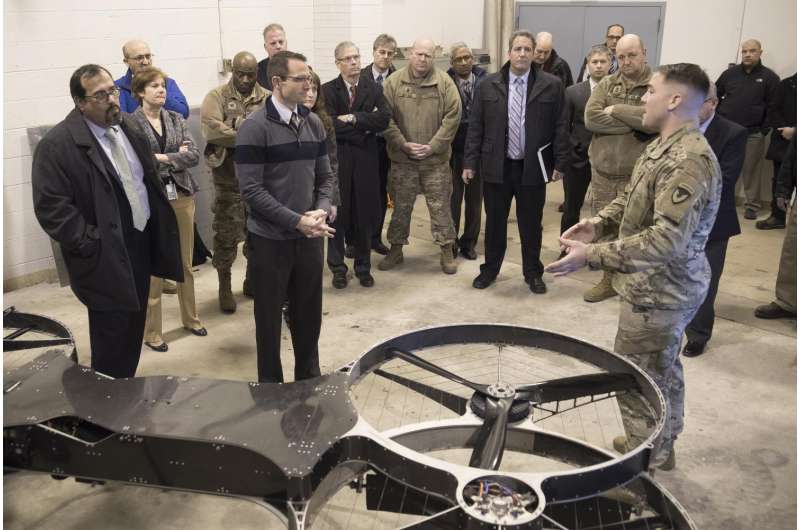January 19, 2017 weblog
The US Army Research Laboratory visitors see quadcopter for resupplying soldiers

(Tech Xplore)—Autonomous re-supply vehicles have the potential of playing a valuable role amidst military actions in the battlefield.
As Jordan Golson, transportation reporter in The Verge wrote, transporting supplies is dangerous work.
Researchers have been turning to solutions that could reduce the number of humans needed to do the job.
"Autonomous vehicles are being tested to convoy supplies across a battlefield, with self-driving minesweepers and giant trucks overseen by a small group of human supervisors bringing up the rear," said Golson. "It's a huge force multiplier (allowing a few people to do the work of many) and potential lifesaver."
Now a video was published earlier this month that shows what the US Army Research Laboratory (ARL) in Maryland has to say about a rectangular-shaped quadcopter and a demo of it during a visit by DoD officials, complete with prototype flight test.
They were showing the Joint Tactical Aerial Resupply Vehicle (JTARV) or also known as the hoverbike. Dr. William Roper, director of the Strategic Capabilities Office at Office of the Secretary of Defense, and members of his staff were on the visit.
An ARL article presented the background of the idea, back to when the laboratory began exploring the JTARV concept in summer 2014. "They identified a manufacturer, Malloy Aeronautics, and a systems integrator, SURVICE, entered into a contract and moved quickly from concept to full-scale prototypes."
What is the purpose? Its formal title says it all —resupplying troops on the frontlines.
Tim Vong, associate chief of ARL's Protection Division, likened the concept to "Amazon on the battlefield."
Researchers envision a future JTARV flying low to the ground or at thousands of feet at speeds of 60 miles per hour or more, said David McNally, ARL Public Affairs.
Vong said in The Engineer that "Anywhere on the battlefield, soldiers can potentially get resupplied in less than 30 minutes."
With a payload capacity of up to 300 pounds, said the video presenter, the vehicle could provide vital re-supply at short distances.
The current prototype is electric, but researchers are looking at a hybrid propulsion system that could dramatically increase range.
There are other items on their list as they move forward in working on JTARV.
"We're exploring increasing payload capacity to 800 pounds and extending the range up to 125 miles," Vong said. "We're also looking to integrate advanced intelligent navigation and mission planning. We're looking to end up with a modular, stable platform that can be used for even more dynamic and challenging missions."
This is a joint effort with the Marine Corps; the collaboration also involves Malloy Aeronautics from the UK. The latter is an R&D company that makes small and large drones.
McNally, meanwhile, wrote that "The JTARV is now a joint effort with the Marine Corps, led by Army researchers, at the Army Armament Research, Development and Engineering Center at Picatinny Arsenal, New Jersey; however, the ARL researchers still serve as subject matter experts on aeromechanics, assessment, analysis, propulsion, intelligence and controls and materials and structures."
© 2017 Tech Xplore


















